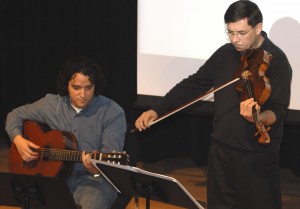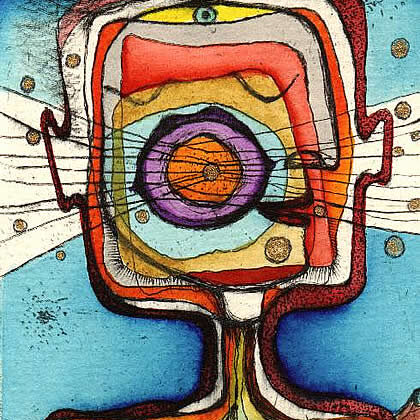On October 22, 2010 Violist Roberto Díaz premiered Ricardo Lorenz’s Canciones de Jara: Concerto for Viola and Orchestra with the Michigan State University Symphony Orchestra under the baton of Leon Gregorian at the Wharton Center for Performing Arts. After consecutive tenures as Principal Violist with the Philadelphia Orchestra and the National Symphony Orchestra, Roberto Díaz currently heads the Curtis Institute of Music and performs extensively as a soloist worldwide.
Canciones de Jara bridges the old concerto model and the more recent genre of the so-called protest song. Lorenz’s intention was to merge the extraordinarily expressive range of violists Roberto Díaz and the lyrical, as well as narrative, content found in the songs by Chilean singer/songwriter Victor Jara (1932-1973). Without resorting to direct referencing (except for the Epilogue), the solo part conveys a wide range of moods embedded in Jara’s lyrics, melodies, and chord progressions. It is almost as thought the viola impersonates the singer/songwriter as he navigates through the dramatic socio-political events that fueled his songs. Sometimes with countertenor-like sweetness and other times with frightening baritone depth, Canciones de Jara captures widely contrasting emotions, whether it is the sad beauty of I Remember Amanda, the melodramatic condemnation present in Questions on behalf of Puerto Montt, the prophetic optimism of I Will Remain Here, or the elegiac stoicism of Song of the Miner.
Ricardo Lorenz on the genesis of Canciones de Jara: Concerto for viola and orchestra
I heard the songs of Victor Jara for the first time when I was twelve. They were playing on my sister’s turntable along with songs by household names like Bob Dylan and Leonard Cohen. I remember vividly Jara’s Te Recuerdo Amanda (I Remember Amanda) or his rendition of Viglieti’s A Desalambrar (Cut the Bard Wire). Above all else, it was his voice and dramatic delivery style that made a lasting impression on me. This was in 1973, during the months following the military coup that swept Chile and sank the country into one of the most repressive regimes of the 20th century. Like my sister and I in Venezuela, many around the world followed in disbelieve the unfolding of this horrible period. Victor Jara was among the many hundreds of Chileans murdered by the military junta during the onset of the repression. But unlike many families of these victims who were told that their loved ones had simply disappeared (and were never seen or heard of again), Victor Jara’s widow was able to burry her husband. It was his popularity that made it impossible for a clerk working at the makeshift morgue not to recognize him even after his handsome features, often watched on TV, were badly disfigured. Sadly, it was this same popularity that made it desirable for the military regime to make a macabre example of Victor Jara in order to instill fear upon any one voicing opposition.

Victor Jara was big already before his tragic death, both as a singer/songwriter of socially and politically driven songs as well as a theatre director with many international appearances. But the fact that he became one of the first casualties of Chile’s military regime made Jara the quintessential protest singer. A false rumor about his hands being amputated in front of a crowd after being forced to play his guitar spread quickly across the Globe, further elevating his status to that of a folk hero.
While living in Chicago in the late 1990s, I became better acquainted with the music of Victor Jara after arranging several of his songs for Macondo Stew, a Latin-fusion band I had with Chilean singer Claudia Pérez. It was towards the end of my time with Macondo Stew that Roberto Díaz, then principal violist with the Philadelphia Orchestra, asked me to compose a concerto for him. After familiarizing myself with the intense and uniquely nuanced sound violist Roberto Díaz delivers, and with Jara’s songs fresh in my head at that time, I knew I had found a meaningful match in a new concerto for viola inspired by Victor Jara’s songs. An invitation by MSU Symphony Director Leon Gregorian; a Grant from Michigan State University’s Office of the Vice-President for Research; and a MacDowell Colony Fellowship gave me the incentive and allowed me to compose the work.
